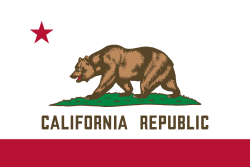More languages
More actions
Verda.Majo (talk | contribs) Tag: Visual edit |
Verda.Majo (talk | contribs) m (→History) Tag: Visual edit |
||
| Line 5: | Line 5: | ||
Over 500 [[Native American]] tribes have lived in the area, and, prior to colonization, a minimum of 100 different languages were spoken among them.<ref name=":0">[https://www.california.com/californian-tribes-regional-guide-golden-state-indigenous-peoples/ “A Guide to California’s Tribes and Indigenous Peoples.”] 2022. California.com. Retrieved 2022-08-14.</ref> In contrast to reservation-based groups, many California Indian groups never received federal acknowledgment from the U.S. [[Settler colonialism|settler-state]]. Native Californians continue to live throughout the state, with or without federal recognition. | Over 500 [[Native American]] tribes have lived in the area, and, prior to colonization, a minimum of 100 different languages were spoken among them.<ref name=":0">[https://www.california.com/californian-tribes-regional-guide-golden-state-indigenous-peoples/ “A Guide to California’s Tribes and Indigenous Peoples.”] 2022. California.com. Retrieved 2022-08-14.</ref> In contrast to reservation-based groups, many California Indian groups never received federal acknowledgment from the U.S. [[Settler colonialism|settler-state]]. Native Californians continue to live throughout the state, with or without federal recognition. | ||
The [[United Farm Workers]] labor union was founded in California in 1962. California is also the location of the founding of the [[Black Panther Party]], which was formed in the city of Oakland in 1966. | The [[United Farm Workers]] labor union was founded in California in 1962. California is also the location of the founding of the [[Black Panther Party]], which was formed in the city of Oakland in 1966. | ||
[[Ronald Reagan]], 40th president of the United States, was the Governor of California from 1967 to 1975. | [[Ronald Reagan]], 40th president of the United States, was the Governor of California from 1967 to 1975. | ||
According to the Prison Policy Initiative, California has an incarceration rate of 549 per 100,000 people (including prisons, jails, immigration detention, and juvenile justice facilities). The Initiative notes that California, similar to other individual U.S. states, "locks up a higher percentage of its people than almost any democracy on earth."<ref>Prison Policy Initiative. 2021. [https://www.prisonpolicy.org/profiles/CA.html “California Profile.”] Prisonpolicy.org.</ref><ref>Prison Policy Initiative. 2021. [https://www.prisonpolicy.org/global/2021.html “States of Incarceration: The Global Context 2021.”] Prisonpolicy.org. [https://web.archive.org/web/2/https://www.prisonpolicy.org/global/2021.html Archived] 2022-08-18.</ref> A dungeon at [[San Quentin State Prison]], dating to 1854, is thought to be California's oldest surviving state-constructed building.<ref>Brown, Patricia Leigh. San Quentin journal. [https://www.nytimes.com/2008/01/18/us/18dungeon.html Prison makes way for future, but preserves past.] [https://web.archive.org/web/20151019025250/http://www.nytimes.com/2008/01/18/us/18dungeon.html Archived] 2015-10-19 at the Wayback Machine ''New York Times'', January 18, 2008. </ref> | According to the Prison Policy Initiative, California has an incarceration rate of 549 per 100,000 people (including prisons, jails, immigration detention, and juvenile justice facilities). The Initiative notes that California, similar to other individual U.S. states, "locks up a higher percentage of its people than almost any democracy on earth."<ref>Prison Policy Initiative. 2021. [https://www.prisonpolicy.org/profiles/CA.html “California Profile.”] Prisonpolicy.org.</ref><ref>Prison Policy Initiative. 2021. [https://www.prisonpolicy.org/global/2021.html “States of Incarceration: The Global Context 2021.”] Prisonpolicy.org. [https://web.archive.org/web/2/https://www.prisonpolicy.org/global/2021.html Archived] 2022-08-18.</ref> In the 1940s, California provided the first of several detention camps for the forced relocation and internment of Japanese Americans.<ref name=":2">[https://www.britannica.com/event/Japanese-American-internment “Japanese American Internment | Definition, Camps, Locations, Conditions, & Facts | Britannica.”] ''Encyclopædia Britannica''. | ||
</ref> A dungeon at [[San Quentin State Prison]], dating to 1854, is thought to be California's oldest surviving state-constructed building.<ref>Brown, Patricia Leigh. San Quentin journal. [https://www.nytimes.com/2008/01/18/us/18dungeon.html Prison makes way for future, but preserves past.] [https://web.archive.org/web/20151019025250/http://www.nytimes.com/2008/01/18/us/18dungeon.html Archived] 2015-10-19 at the Wayback Machine ''New York Times'', January 18, 2008. </ref> | |||
== History == | == History == | ||
| Line 24: | Line 26: | ||
In 1891, the state of California took over executions of prisoners from the state's individual counties and began carrying out death sentences at [[Folsom State Prison]], east of [[Sacramento]]. San Quentin joined this practice two years later. A total of 215 “judicial hangings” were carried out on San Quentin’s gallows over the next 45 years. San Quentin became the state's sole designated prison for executions in 1938 when the state unveiled its new two-seater gas chamber, nicknamed “The Smokehouse” by those waiting to die. | In 1891, the state of California took over executions of prisoners from the state's individual counties and began carrying out death sentences at [[Folsom State Prison]], east of [[Sacramento]]. San Quentin joined this practice two years later. A total of 215 “judicial hangings” were carried out on San Quentin’s gallows over the next 45 years. San Quentin became the state's sole designated prison for executions in 1938 when the state unveiled its new two-seater gas chamber, nicknamed “The Smokehouse” by those waiting to die. | ||
When the U.S. government ordered the forced relocation of thousands of Japanese Americans to detention camps during World War II, the first camp to go into operation was [[Manzanar]], located in southern California.<ref name=":2" /> | |||
=== 1960s and 70s === | === 1960s and 70s === | ||
Revision as of 05:50, 18 August 2022
' State of California | |
|---|---|
|
Flag | |
Motto: Eureka | |
Anthem: I love you, California | |
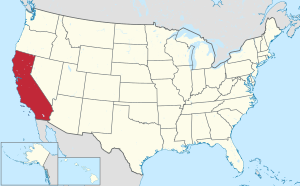 |
 | This article is a stub. You can help improve this article by editing it. |
California is a state within the United States of America. Its population and economy is among the largest in the USA.[1]
Over 500 Native American tribes have lived in the area, and, prior to colonization, a minimum of 100 different languages were spoken among them.[2] In contrast to reservation-based groups, many California Indian groups never received federal acknowledgment from the U.S. settler-state. Native Californians continue to live throughout the state, with or without federal recognition.
The United Farm Workers labor union was founded in California in 1962. California is also the location of the founding of the Black Panther Party, which was formed in the city of Oakland in 1966.
Ronald Reagan, 40th president of the United States, was the Governor of California from 1967 to 1975.
According to the Prison Policy Initiative, California has an incarceration rate of 549 per 100,000 people (including prisons, jails, immigration detention, and juvenile justice facilities). The Initiative notes that California, similar to other individual U.S. states, "locks up a higher percentage of its people than almost any democracy on earth."[3][4] In the 1940s, California provided the first of several detention camps for the forced relocation and internment of Japanese Americans.[5] A dungeon at San Quentin State Prison, dating to 1854, is thought to be California's oldest surviving state-constructed building.[6]
History
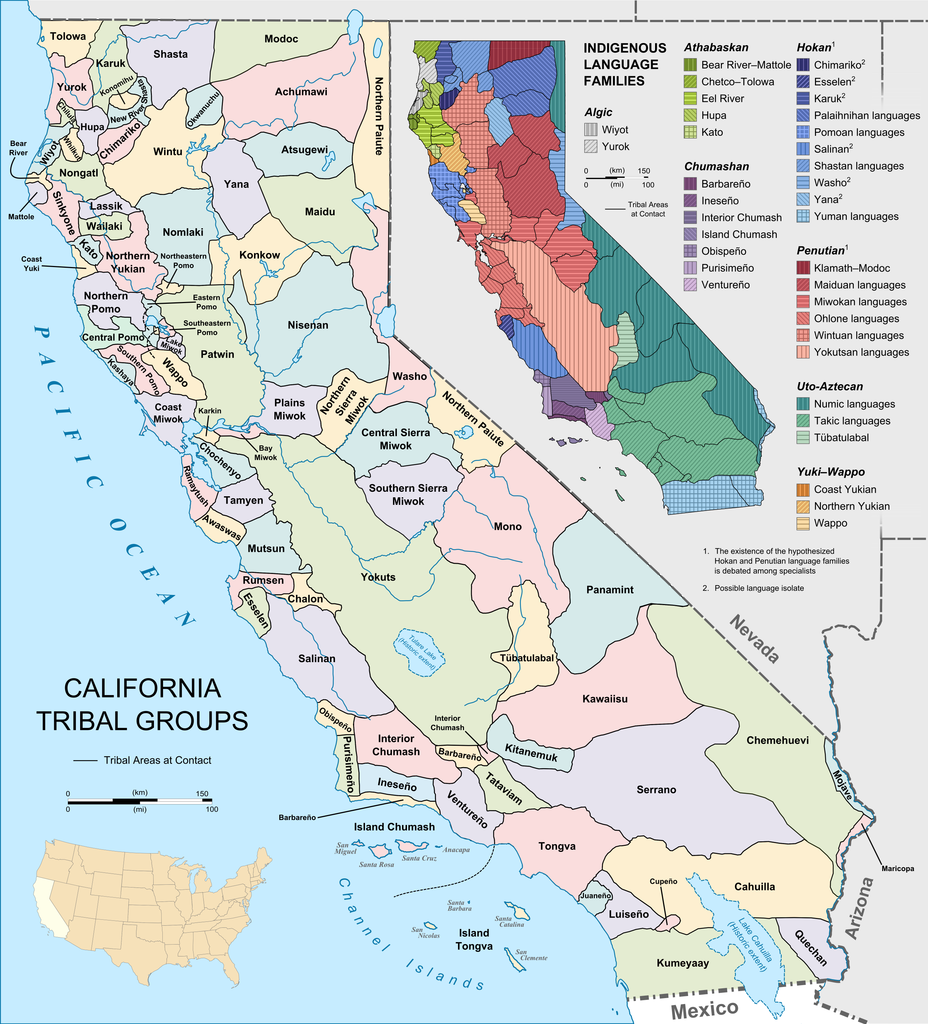
Early history
The earliest human occupation in the area of the state dates back 19 thousand years. The Indigenous peoples of California spoke a minimum of a hundred different languages at the time, had their own specific food cultures, and distinct religious beliefs. In the late 18th century, over 300,000 people were living in the state.[2]
From 1769 to 1800, the California coast was under Spanish control from San Francisco in the north to San Diego in the south. The Spanish mission system was a method of colonization in the area that used religious doctrine heavily in its self-justification. The Spanish used Native Californian's labor to build the missions and abused, exploited, and murdered the people. Meanwhile, Native Californians consistently resisted Spanish rule.[7]
In 1848, California came under the rule of the United States, which was soon followed by the California genocide, in which the California settler-state and federal authorities incited, aided, and financed the violence against the Native Californians. The California Act for the Government and Protection of Indians was enacted in 1850 (amended 1860, repealed 1863). This law provided for "apprenticing" or indenturing Indian children to Whites, and also punished "vagrant" Indians by "hiring" them out to the highest bidder at a public auction if the Indian could not provide sufficient bond or bail, effectively legalizing a form of slavery targeting Native Californians.[8]
In An American genocide: the United States and the California Indian catastrophe, 1846-1873, author Benjamin Madley writes that the "organized destruction of California's Indian peoples under US rule was not a closely guarded secret" and that "California newspapers frequently addressed, and often encouraged, what we would now call genocide, as did some state and federal employees." Madley also quotes US Indian Affairs commissioner John Collier as saying, "The world's annals contain few comparable instances of swift depopulation--practically, of racial massacre--at the hands of a conquering race."[9]
In 1891, the state of California took over executions of prisoners from the state's individual counties and began carrying out death sentences at Folsom State Prison, east of Sacramento. San Quentin joined this practice two years later. A total of 215 “judicial hangings” were carried out on San Quentin’s gallows over the next 45 years. San Quentin became the state's sole designated prison for executions in 1938 when the state unveiled its new two-seater gas chamber, nicknamed “The Smokehouse” by those waiting to die.
When the U.S. government ordered the forced relocation of thousands of Japanese Americans to detention camps during World War II, the first camp to go into operation was Manzanar, located in southern California.[5]
1960s and 70s
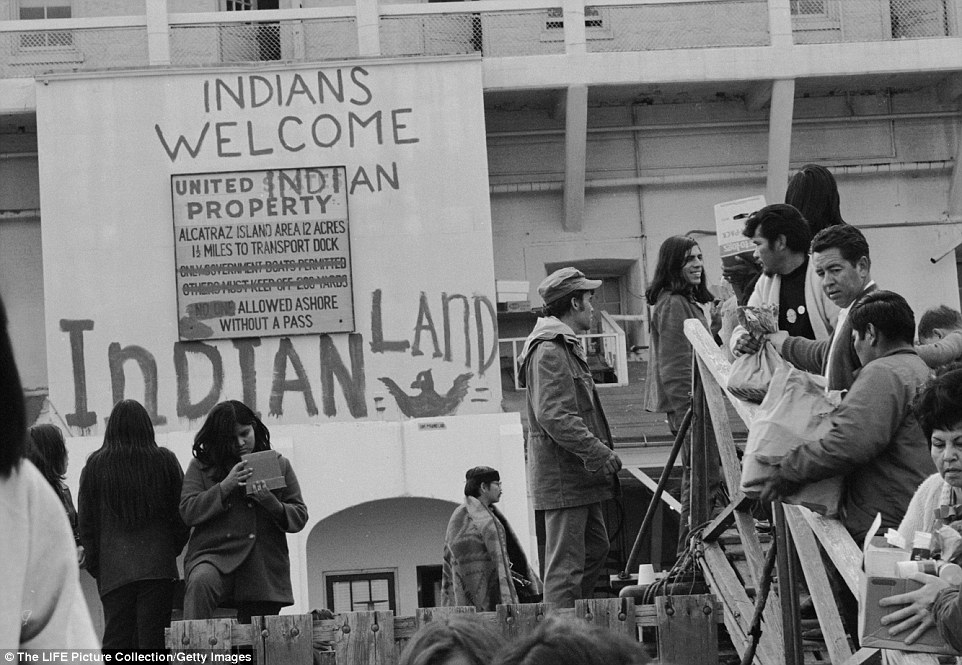
The United Farm Workers labor union was founded in California in 1962.
The Black Panther Party (BPP), originally the Black Panther Party for Self-Defense, was founded in 1966 in Oakland, California.
On March 9, 1964, five Sioux Indians occupied Alcatraz Island, location of Alcatraz Federal Penitentiary which had closed in 1963, for four hours, claiming it on the basis of the Sioux Treaty of 1868, which held that any surplus federal property would revert back to Native American ownership.[10]
A more extensive occupation occurred from November 20, 1969 to June 11, 1971, as Native American activists and their supporters occupied Alcatraz for 19 months, living on the island together until the government switched off electricity, water and telephone service and federal marshals arrived to remove the last of the occupiers.[11] In 1972, the National Park Service purchased Alcatraz along with Fort Mason from the U.S. Army to establish the Golden Gate National Recreation Area.
Ronald Reagan, 40th president of the United States from 1981 to 1989, was the Governor of California from 1967 to 1975.
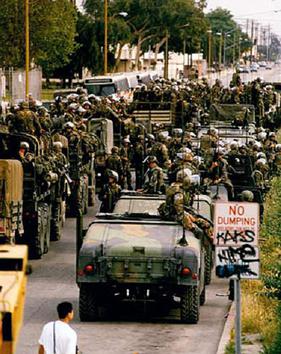
1980s and 90s
On June 5, 1981 Michael Gottlieb, MD of the University of California, Los Angeles and others authored the first report identifying the appearance of diseases that would later become known as AIDS. In 1982 the San Francisco AIDS Foundation was founded.[12]
In 1992, an uprising occurred in Los Angeles, commonly known as the 1992 Los Angeles Uprising or 1992 Los Angeles Riots. Unrest began in South Central Los Angeles on April 29, after a jury acquitted four officers of the Los Angeles Police Department (LAPD) charged with using excessive force in the arrest and beating of Rodney King. The verdict of the case of the killing of 15 year old girl Latasha Harlins by a convenience store owner also influenced the tensions leading up to the unrest. The uprising took place in several areas in the Los Angeles metropolitan area as thousands of people rioted over six days following the verdict announcement of the Rodney King case.
2000s to present
California has carried out 10 executions by lethal injection, the most recent was in 2006.[13] In 2006, the state of California paid $853,000 for its new lethal injection chamber in San Quentin, which was intended to conform with modern court rulings on cruel and unusual punishment and to provide a more "humane" means of execution. However, the new lethal injection chamber has never been used and was decommissioned in 2019 when Gov. Gavin Newsom declared a moratorium on executions in the state.[13]
References
- ↑ "California Population 2022" (2022). World Population Review. Retrieved 2022-8-13.
- ↑ 2.0 2.1 “A Guide to California’s Tribes and Indigenous Peoples.” 2022. California.com. Retrieved 2022-08-14.
- ↑ Prison Policy Initiative. 2021. “California Profile.” Prisonpolicy.org.
- ↑ Prison Policy Initiative. 2021. “States of Incarceration: The Global Context 2021.” Prisonpolicy.org. Archived 2022-08-18.
- ↑ 5.0 5.1 “Japanese American Internment | Definition, Camps, Locations, Conditions, & Facts | Britannica.” Encyclopædia Britannica.
- ↑ Brown, Patricia Leigh. San Quentin journal. Prison makes way for future, but preserves past. Archived 2015-10-19 at the Wayback Machine New York Times, January 18, 2008.
- ↑ “Five Views: An Ethnic Historic Site Survey for California (American Indians).” 1988. Nps.gov. California Department of Parks and Recreation. Office of Historic Preservation.
- ↑ Ojibwa (March 2, 2015). "California's War On Indians, 1850 to 1851". Native American Netroots.
- ↑ Benjamin Madley (2016). An American genocide: the United States and the California Indian catastrophe, 1846-1873. New Haven: Yale University Press.
- ↑ Kahle, Thomas. "Breaking Point: The 1969 American Indian Occupation of Alcatraz Island." Coe College. Penn History Review. Volume 26, Issue 2, Article 4. February 2020. Archived 2022-08-18.
- ↑ Leach, Naomi. “Idyllic Teepees at the US’s Most Notorious Prison: Fascinating Photos Reveal Life on the Rock in the late 1960s when Native Americans occupied Alcatraz” Daily Mail. November 15, 2016.
- ↑ “40 Years of AIDS: A Timeline of the Epidemic.” 2021. 40 Years of AIDS: A Timeline of the Epidemic | UC San Francisco. June 4, 2021. Archived 2022-08-18.
- ↑ 13.0 13.1 Hardy, A.J. “The End of the Line for Death Row?” San Quentin News. Sanquentinnews.com. April 18, 2022. Archived 2022-08-18.

